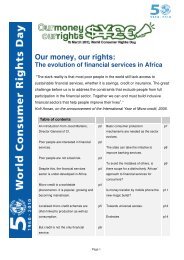Voices for Change: the Consumer Right to Representation
Voices for Change: the Consumer Right to Representation
Voices for Change: the Consumer Right to Representation
You also want an ePaper? Increase the reach of your titles
YUMPU automatically turns print PDFs into web optimized ePapers that Google loves.
World <strong>Consumer</strong> <strong>Right</strong>s Day 2002: <strong>Voices</strong> <strong>for</strong> <strong>Change</strong><br />
They must be viewed as “legitimate” pressure<br />
groups in order <strong>to</strong> be taken seriously by<br />
government agencies. This can prove<br />
restrictive in countries where <strong>the</strong> requisite<br />
political and cultural space <strong>for</strong> dissent does<br />
not exist. Many consumer groups do not<br />
undertake (or have ceased <strong>to</strong> undertake)<br />
public interest litigation <strong>for</strong> this reason.<br />
O<strong>the</strong>rs temper <strong>the</strong>ir criticism of government<br />
policies within “acceptable” limits, since court<br />
challenges and criticism may be regarded as<br />
outside <strong>the</strong> “rules of <strong>the</strong> game.” This can<br />
compromise consumer representation. Groups<br />
that are distrusted by government agencies<br />
may have difficulty getting access <strong>to</strong><br />
in<strong>for</strong>mation and in being included in <strong>the</strong><br />
consultation process. Lack of access <strong>to</strong> <strong>the</strong><br />
policy-making process may mean <strong>the</strong>ir views<br />
are not aired.<br />
State of Play<br />
To assess <strong>the</strong> state of play, a survey of CI’s<br />
members was carried out <strong>for</strong> this WCRD.<br />
Approximately 70 consumer groups from<br />
around <strong>the</strong> world gave detailed descriptions of<br />
where <strong>the</strong>y are active, <strong>the</strong> extent of <strong>the</strong>ir<br />
participation, obstacles faced, <strong>the</strong>ir successes<br />
and continuing needs (see Annex A). The<br />
responses <strong>to</strong> this survey are analysed in<br />
Chapter 5 and a sample of <strong>the</strong> questionnaire<br />
can be found in Annex D.<br />
Overall analysis of <strong>the</strong> survey shows that<br />
consumer representation is relatively extensive<br />
in some areas but not in o<strong>the</strong>rs. Leading <strong>the</strong><br />
list are consumer policy and protection, food<br />
security and safety and technical standards.<br />
Where <strong>the</strong>re is representation, impact has been<br />
described as more positive than negative,<br />
rarely very poor and sometimes excellent.<br />
Levels of representation tapers off <strong>for</strong><br />
competition, trade/economics, education,<br />
communications/in<strong>for</strong>mation technology,<br />
social issues/poverty alleviation, price<br />
controls, gender/women, financial services<br />
regulation and transportation.<br />
Interestingly, CI government members who<br />
replied <strong>to</strong> this questionnaire cried out <strong>for</strong> <strong>the</strong><br />
need <strong>for</strong> independent consumer organisations.<br />
“The absence of a strong consumer movement<br />
limits <strong>the</strong> participation of consumers in policymaking<br />
process on matters that affect <strong>the</strong>m,”<br />
wrote Wendy Williams of <strong>the</strong> governmental<br />
<strong>Consumer</strong> Affairs Division in Trinidad and<br />
Tobago. Here and elsewhere, government<br />
consumer protection agencies sought a<br />
stronger role <strong>for</strong> NGOs – in part because<br />
“one major disadvantage of a government<br />
consumer agency is <strong>the</strong> perception that it is<br />
not interested primarily in <strong>the</strong> interests of<br />
consumers,” she notes.<br />
However, government members responding <strong>to</strong><br />
<strong>the</strong> questionnaire gave few details of <strong>the</strong> ways<br />
that <strong>the</strong>y <strong>the</strong>mselves choose <strong>to</strong> represent<br />
consumer interests across government.<br />
Descriptive case studies of <strong>the</strong> impact of<br />
consumer representation on specific policies –<br />
and thus on <strong>the</strong> lives of consumer <strong>the</strong>mselves<br />
– illustrated both <strong>the</strong> value of working within<br />
<strong>the</strong> system and <strong>the</strong> need <strong>to</strong> be willing <strong>to</strong> raise<br />
challenges from without. These are<br />
summarised in Annexes B and C. Successes<br />
ranged from improved standards <strong>for</strong> condoms,<br />
manda<strong>to</strong>ry genetically modified (GM) food<br />
labelling, improved basic services and <strong>the</strong><br />
creation of alternative dispute resolution<br />
systems. Tactics included scientific testing,<br />
canvassing of members, lobbying, media<br />
outreach, peaceful protests and pulling out of<br />
government committees when consumer needs<br />
were being s<strong>to</strong>newalled. High on <strong>the</strong> list of<br />
needs <strong>for</strong> better representation is access <strong>to</strong><br />
more opportune in<strong>for</strong>mation when sitting on<br />
committees, greater influence in <strong>the</strong> legislative<br />
arena and <strong>the</strong> creation of new mechanisms in<br />
areas such as transportation, medical ethics<br />
and research. Case studies also stressed <strong>the</strong><br />
importance of legal action as a <strong>for</strong>m of<br />
representation, both as a means of exerting<br />
pressure and as a <strong>for</strong>m of obtaining redress.<br />
Given <strong>the</strong> challenges of representation,<br />
Chapter 6 assesses <strong>Consumer</strong>s International’s<br />
work at representing consumers on <strong>the</strong><br />
different <strong>to</strong>pics at <strong>the</strong> regional and global<br />
levels in different institutions.<br />
WCRD Action<br />
To foster effective consumer representation,<br />
action is necessary. World <strong>Consumer</strong> <strong>Right</strong>s<br />
11






![pkef]Qmf eg]sf] s] xf] < - Consumers International](https://img.yumpu.com/6479658/1/184x260/pkefqmf-egsf-s-xf-consumers-international.jpg?quality=85)
